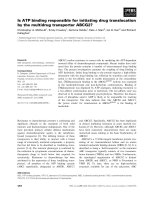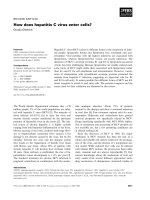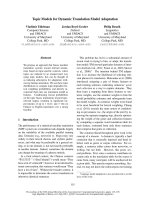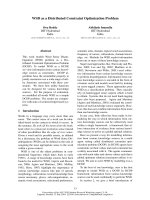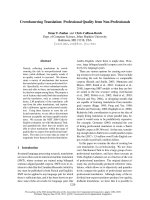Tài liệu Báo cáo khoa học: "Is There Natural Language after Data Bases?" pptx
Bạn đang xem bản rút gọn của tài liệu. Xem và tải ngay bản đầy đủ của tài liệu tại đây (168.41 KB, 2 trang )
Is There Natural Language
after Data Bases?
Jaime G. Carbonell
Computer Science Department
Carnegie-Mellon University
Pittsburgh, PA 15213
1.
Why Not Data Base
Query?
The undisputed favorite application for natural language
interfaces has been data base query. Why? The reasons range
from the relative simplicity of the task, including shallow semantic
processing, to the potential real-world utility of the resultant
system. Because of such reasons, the data base query task
was
an excellent paradigmatic problem for computational linguistics,
and for the very same reasons it is now time for the field to
abandon its protective cocoon and progress beyond this rather
limiting task. But, one may ask, what task shall then become the
new paradigmatic problem? Alas, such question presupposes
that a single, universally acceptable, syntactically and
semantically challenging task exists. I will argue that better
progress can be made by diversification and focusing on different
theoretically meaningful problems, with some research groups
opting to investigate issues arisinq from the development of
integrated multi-purpose systems.
2. But I
Still Like Data
Bases
Well, then, have I got the natural language interface task
for
you! Data base update presents many unsolved problems not
present in pure query systems. "Aha," the data base adherents t
would say, "just a minor extension to our workU' Not at all; there
is nothing minor about such an extension [4]. Consider, for
example, the following update request to an employee-record
data base:
"Smith should work with the marketing team and Jones with
sales"
First, the internal ellipsis in the coordinate structure is typical of
such requests, but is mostly absent from most DB queries.
However, let us assume that such constructions present no
insurmountable problems, so that we can address an equally
fundamental issue: What action should the system take? Should
Smith be deleted from sales and added to marketing (and vice
versa for Jones)? Or, should Smith and Jones remain fixed points
while all other sales and marketing employees are swapped? As
Kaplan and Davidson [3] point out, one can postulate heuristics to
ameliorate the problem. They proposed a minimal mutilation
criterion, whereby the action entailing the smallest change to the
11 must confess that I would have to include myself in any group claiming
adherence to data base query as a unify=ng task. I am still actively working in the
area, and to some extent expect to contmue doing so. The practical applications
are immense, but theoretical breakthroughs require fresh ideas and more
challenging problems. Hence I advocate a switch based on scientific research
criteria, rather than practical applicability or engineering significance.
data base is preferred. However, their bag of tricks fails miserably
when confronted with examples such
as:
"The sales building should house the marketing people and
vice versa"
Applying the above heuristic, the bewildered system will prefer to
uproot the two buildings, swap them, and lay them on each
other's foundations. Then, only two DB records need to be
changed. Such absurdities can only be forestalled if a semantic
model of the underlying domain is built and queried, one that
models actions, including their preconditions and consequences,
and knows about objects, relations, and entailments.
So, data base update presents many difficult issues not
apparent in the simpler data base query problem. Why not, then,
select this as the paradigmatic task? My only objection i3 to the
definite article the I advocate data base update as one of several
theoretically significant tasks with major practical utility that
should be selected. Other tasks highlight additional problems of
an equally meaningful and difficult nature.
3.
How Should I Select A Good Task
Domain?
At the risk of offending a number of researchers in
computational linguistics, I propose some selection criteria
illustrated both by tasks that fail to meet them, and later by a
much better set of tasks designed to satisfy these criteria for
theoretical significance, and computational tractability.
1. The task should, if possible, be able to build upon past work,
rather than addressing a completely disjoint set of problems.
This quality enhances communication with other researchers,
and enables a much shorter ramp-up period before
meaningful results can be obtained. For instance, an
automated poetry comprehension device fails to meet this
criterion.
2. The task should be computationally tractable and grounded in
an external validation test. Interfaces to as yet non-existent
systems, or ones that must wait for radically new hardware
(e.g., connectionist machines) before they can be
implemented fail to meet this criterion. However, data base
query interfaces met this criterion admirably.
3. The task should motivation investigation of a set of language
phenomena of recognizable theoretical significance that can
be addressed from a computational standpoint. Ideally, the
task should focus on restricted instances of a general and
difficult phenomenon to encourage progress towards initial
solutions that may be extended to (or may suggest) Solutions
to the general problem. Data base query has been thoroughly
186
mined for such phenomena; hence it is time to go prospecting
on virgin land.
4. The task should be of practical import, or should be a major
step towards a task of practical import. Aside from very real if
mundane concerns of securing funding, one desires a.large,
eager, potential user community as an inexhaustible source of
examples, needs, encouragement, and empirical motivation
and validation. A parser for Summerian cunneiform tablets or
a dialog engine built around the arbitrary rules of a talk-show
game such as "You don't say" would completely fail on this
criterion.
4.
What Then Are Some Other
Paradigmatic Tasks?
Armed with the four criteria above, let us examine some tasks
that promise to be quite fruitful both as vehicles for research and
as means of providing significant and practical natural language
interfaces.
• Command Interfaces to Operating Systems -
Imperative
command dialogs differ from data base queries in many
important ways beyond the obvious differences in surface
syntactic structure, But, much of the research on limited-
domain semantics, ambiguity resolution, ellipsis and anaphora
resolution can be exploited, extended and implemented in
such domains. Moreover, there is no question as to the
practical import and readily-available user community for such
systems. What new linguistic phenomena do they highlight?
More than one would expect. In our preliminary work leading
up the the PLUME interface to the VMS operating system, we
have found intersentential meta-language utterances, crass-
party ellipsis and anaphora, and dynamic language
redefinition, to name a few. An instance of intersentential
meta.language typical to this domain would
be:
USER:
Copy foo.bar to my directory.
SYST:
File copied to/carbonell]foo.bar.
USER:
Oops, I meant to copy lure.bar.
There is no "oops command", nor any act for editing, re-
executing, and undoing the effects of a prior utterance in the
discourse. This is a phenomenon not heretofore analyzed,
but one whose presence and significance was highlighted by
the choice of application domain. See[2] for additional
discussion of this topic.
• Interfaces to expert systems
There is little question
about the necessity, practicality and complexity of such a
task. One can view expert systems as reactive, super data
bases that require deduction in addition to simple retrieval. As
such, the task of interpreting commands and providing
answers is merely an extension of the familiar data-base
retrieval scenario. However, much of the interesting human
computer interaction with expert systems, as we discovered in
our XCALIBUR interface[I], goes beyond this simple
interaction. To wit, expert system interfaces
require:
o Mixed-initiative communication, where the system must
take the initiative in order to gather needed information
from the user in a focused manner.
o Explanation generation, where the system must justify its
conclusion in human-comprehensible terms, requiring
user modelling and comparative analysis of multiple viable
deduction paths.
o Knowledge acquisition, where information supplied in
natural language must be translated and integrated into
the internal workings of the system.
• Unified multi-function interfaces
Ideally one would
desire communication with multiple "back ends" (expert
systems, data bases, operating systems, utility packages,
electronic mail systems, etc.) through a single uniform natural
language interface. The integration of multiple discourse
goals and need to transfer information across contexts and
subtasks present an additional layer of problems mostly at
the dialog structure level that are absent from interfaces to
single-task, single-function backends.
The possible applications meeting the criteria have not by any
means been enumerated exhaustively above. However, these
reflect an initial set, most of which have received some attention
of late from the computational linguistics community, and all
appear to define theoretically and practically fruitful areas of
research.
5.
References
1. CarbonelL J.G., Boggs, W.M., Mauldin, M.L. and Anick, P.G.,
"The
XCALIBUR Project, A Natural Language Interface to Expert Systems,"
Proceedings of the Eighth International Joint Conference Dn Artificial
Intelligence. 1983.
2. Carbonell, J. G "Meta-Language Utterances in Purposive Discourse," Tech.
report, Carnegie.Mellon University, Computer Science Department, 1982.
3. Kaplan. S.J. and Davidson, J., "Interpreting Natural Language Data Base
Updates,"
Proceedings of the 19th Meeting of the Association for
Computational Linguistics.
1981.
4. Salvater. S., "Natural Language Data Ba,s~ Update," Tech. report 84/001,
Boston University, 1984.
187


